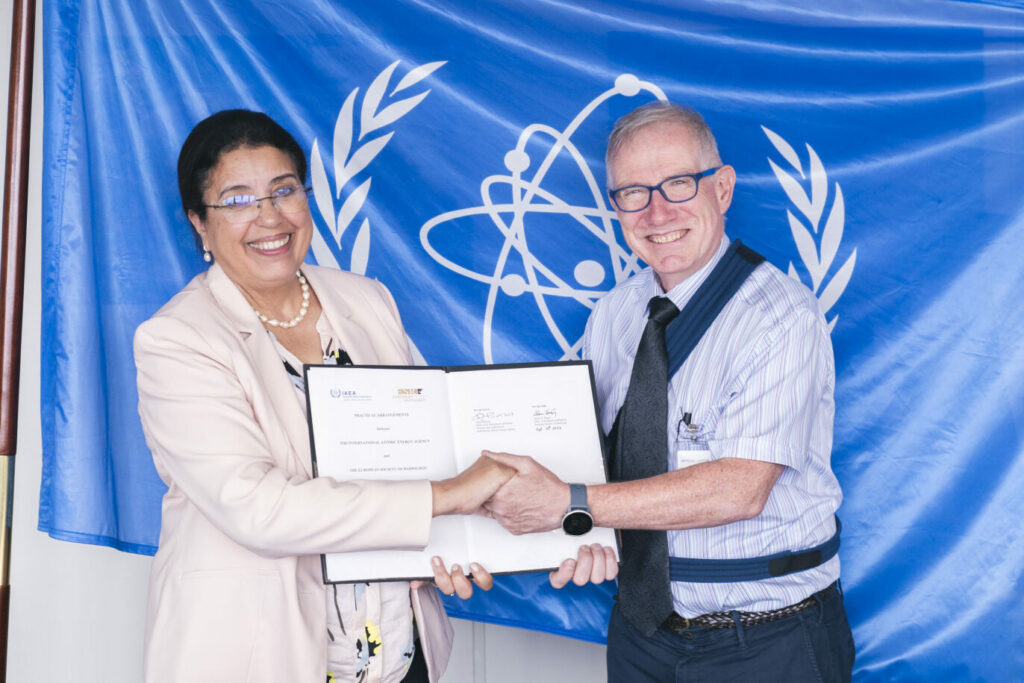Thursday, September 14, 2023 (ESR, Vienna) – The International Atomic Energy Agency (IAEA) and the European Society of Radiology (ESR) have extended their Practical Arrangements on cooperation in the area of diagnostic imaging, including hybrid imaging, until 2026, with an expanded scope of collaboration.
The Practical Arrangements were signed for the first time in February 2017 as the first agreement of its kind between the IAEA and an international medical imaging society and thereby set a milestone in the ESR’s engagement with international organisations. By elevating the two organisations’ longstanding relations to a more formal level, the agreement opened up new opportunities in supporting global efforts in the field of medical imaging and was, therefore, renewed in 2020.
“The good cooperation that has developed between the IAEA and the European Society of Radiology under our first Practical Arrangement provides a solid foundation for further collaboration to build global capacity in diagnostic imaging, particularly in low- and middle-income countries. I look forward to intensifying and expanding this valuable and dynamic relationship”, said IAEA Deputy Director General and Head of the Department of Nuclear Sciences and Applications, Najat Mokhtar.
The agreement focuses on capacity building and education in the field of diagnostic imaging including hybrid imaging, engaging not only radiologists, but a wider audience, including referring physicians.
As a result of the Arrangements, the IAEA and the ESR have cooperated successfully during the past six years on capacity building in low- and middle-income countries, educational activities, and measures to improve quality and safety in medical imaging.
Recent examples include joint promotion of online access to the European Congress of Radiology (ECR), which was followed by a total of 11,004 participants in 2023 (onsite and online). For ECR 2023, the IAEA supported online access for 500 professionals from low- and middle-income countries. The ESR also contributed expert speakers to several IAEA conferences during the last six years, including the International Conference on Integrated Medical Imaging in Cardiovascular Diseases (IMIC-2022). In addition, ESR EuroSafe Imaging and IAEA jointly organised free-access sessions at ECRs. Through its collaboration with the IAEA Division for Africa and the Technical Cooperation’s AFRA project, the ESR has offered its clinical decision support system, the ESR iGuide stand-alone portal, in English and French to approx. 30 hospitals in Africa. Collaboration in the framework of European Commission tender projects is another example of successfully joining forces.
Welcoming the extension, Prof. Adrian Brady, Chairman of the ESR Board of Directors, stated that “the IAEA-ESR Practical Arrangements bear witness to the ESR’s role as a trustworthy stakeholder in healthcare policy at the international level. As the largest radiological society in the world, the ESR offers a broad range of educational sources to its more than 130,000 members around the globe. Thanks to our reach and strong educational programme and the IAEA’s expertise and status as an international authority, we will be able to support an even wider audience in training and capacity building.”
The Practical Arrangements were first signed following several years of fruitful working relationships between the ESR and the IAEA, in particular its Diagnostic Imaging and Nuclear Medicine Section, on issues of common interest. In 2014, the ESR was the first medical society to respond to the IAEA’s Bonn Call for Action by launching the EuroSafe Imaging radiation protection campaign, committing to specific actions in the priority areas set out in the Bonn call.
Acknowledging the role that non-governmental stakeholders play for the IAEA, Diana Paez, Head of the Diagnostic Imaging and Nuclear Medicine Section, considered “the IAEA’s cooperation with major professional organisations such as the ESR as vital to increase the support we provide to Member States in the area of diagnostic imaging. The extension of the agreement will open up new opportunities to further expand our global outreach and to fulfil our mandate to support our Member States in the field of imaging, taking into consideration their specific needs”.
Prof. Brady concluded that “On behalf of the ESR, I wish to sincerely thank the IAEA for its ongoing commitment to diagnostic imaging and for granting us the opportunity to continue and even expand our collaboration on a high level. I greatly look forward to many new fruitful joint initiatives to the ultimate benefit of the patients.”
Contact:
ESR Department of European and International Affairs
Am Gestade 1, 1010 Vienna, Austria
Phone: + 43 1 533 4064-20
[email protected] | www.myESR.org










